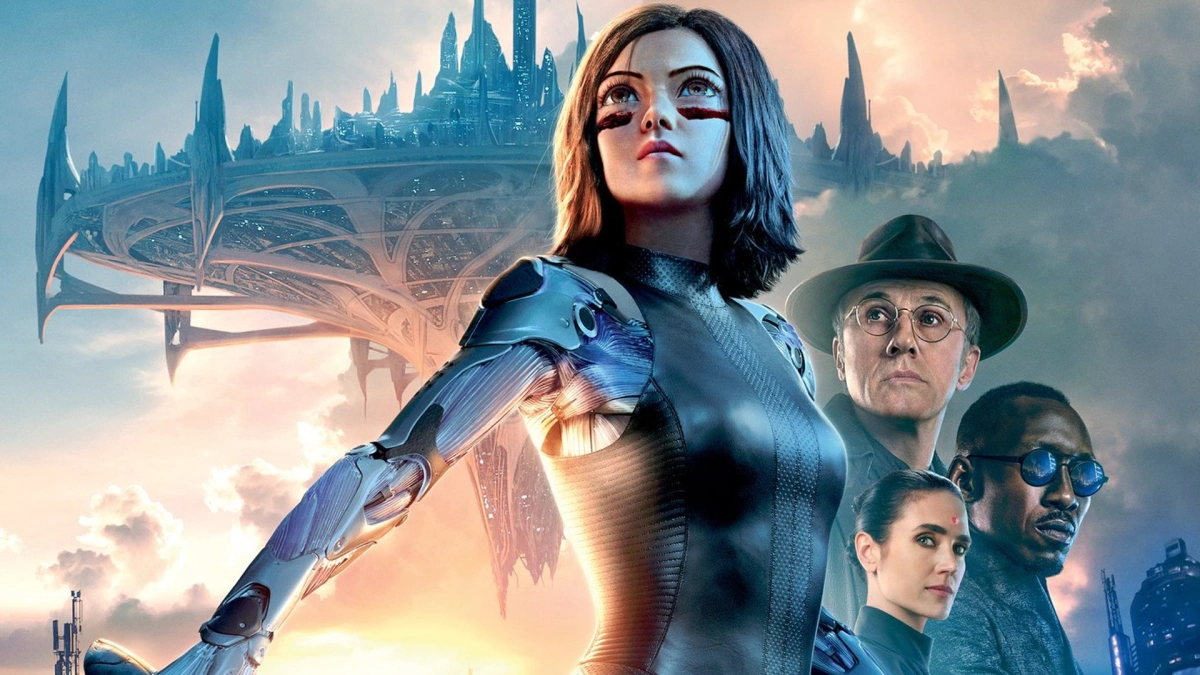The 2019 cyberpunk film Alita: Battle Angel is the first and currently the only big-screen adaptation of a famous Japanese manga series Gunnm (also known in English as Battle Angel Alita). The story is about, well, Alita, a teenage cyborg on a soul-searching journey through the post-apocalyptic world in the distant future full of cybernetics. The manga is an impressive work of art and a marvelous fictional tale, whereas the adaptation is an equally amazing blend of CGI and live-action film.

The film opens with a modified logo of the production company. Instead of the usual 20th Century Fox intro, viewers are presented with an amusing transformation of the “20th” into “26th” in the last seconds; it is not much of a CGI, but a fun surprise nevertheless. Such a simple alteration befits the story because events in Alita are set in the year 2563, or about 300 years after the collapse of the civilized world. Since then, humanity has been split into two major factions: the privileged citizens inhabiting the city sky of Zalem and the working-class group in the Iron City, where most of the actions happen.
Alita first appears as a nameless, amnesiac, and terminally injured waif. No one, not even Alita—at least in the first few scenes—is aware of her true identity as a formidable warrior. Her tricky path of self-discovery turns out to be an adventure full of action sequences and sweet romantic stories.
Unlike in Zalem where everyone lives large, Iron City is an overly futuristic version of the wild west. Massive robots patrol the city streets, cyborgs are killed and harvested for parts, and basically the weak must give way to the strong. It is a massive place of wonderful ruins scattered with seemingly borderless junkyards and carefully-crafted industrial-style architecture (or rather crumbling buildings, depending on how you see it).
Among the few good citizens of the Iron City is Dr Dyson Ido, a cyber-scientist who discovers the dismembered yet still very much alive Alita in a one of the city’s junkyards. She is only head and torso at that time until Ido does some repairs and gives her robotic organs to complete the anatomy. It is Ido who names her Alita, after his deceased daughter.

Soon enough Alita gets along quite well in the city meets some friends, falls in love with a scrap dealer, and encounters many villains. She still doesn’t know her true identity, and the answer to her quest is revealed little by little as the film progresses. Over the course of Alita’s search for the truth, she opens a lot of doors to other mysteries. In fact, there might be enough stories in the plotline that at many points the pace feels a tad too fast for any tension to build up with proper excitement. You barely have a chance to anticipate anything and make an incorrect guess about what will happen.
Before she eventually realizes her true origin as one of the greatest cyborg warriors in existence, she is forced to tackle a series of action-packed challenges to the viewers’ delight. Alita gets involved in a serial killer investigation, works as a bounty hunter, and enrols in a dead-or-alive cyborg tournament. The young adult romance between Alita and the scrap dealer Hugo receives notable runtime, but a large portion of the film is devoted to the tournament called “motorball” where cyborgs essentially are fighting each other in a Rollerball-style spectator sport. Hugo wants to go to Zalem, and Alita is trying to win the prize money from the tournament to send him there.
The film adaptation is comprised of multiple stories taken from the first four volumes of the source material, giving it an unmistakably episodic structure. Alita is always in a hurry to complete a major storyline that concludes in a climactic ending before another begins. The result is nonstop action, even more ferociously in 3D, where viewers are in the direct trajectory of destroyed robotic parts and every imaginable cyborg weapon. The actions come out more acrobatic than bloody and violent, but many scenes are still full of too much gore to be regarded as family-friendly.
True Cyborg
Alita: Battle Angel makes for a showcase of how CGI and live-action blend seamlessly in an adaptation of the manga or comic book. Action sequences in comic books are typically over-the-top and the visual difference between artwork and real people often sets up any adaptation for failure. In manga and comics, characters can be as distinctive or expressive as the artists want them. In a live-action (as opposed to animated) adaptation, retaining all the comic book peculiarities can be a monumental challenge.

Computer-generated sets and performance capture bring Alita from the pages of the manga series to the big screen without faults. Devoted fans of the source material are spoiled with the artwork, while casual moviegoers never really have to read the books first to understand the film’s many storylines and to enjoy the view. Alita is a visual treatment indulgence thanks to its gorgeous world-building and immersive 3D experience.
Performance capture technology allows Alita to appear as a convincing cyborg without sacrificing all her natural human characteristics. She is supposed to be a real person who is enhanced by biotechnological organs, and the film delivers. Portrayed by Rosa Salazar, the character maintains the ability to convey realistic facial expressions and deep emotions as well as tenderness and ferocity despite her robotic body or huge CGI eyes.
Although Alita: Battle Angel does not really break the mold in terms of theme and storytelling, the motion picture is nothing short of a wonderful production. The locations are fascinating, the cybernetic world is detailed, and the actions are phenomenal. It is an ambitious film with just the right ingredients to make its fantastical world seem real.
Apart from the spectacular CGI, do you think Alita: Battle Angel gives enough respect to the source material? Let us know. We’d love to hear from you.
Other things you might want to know:
Is James Cameron the director?
No, James Cameron is not the director. Alita: Battle Angel is directed by Robert Rodriguez whose portfolio includes Spy Kids and Sin City. James Cameron is a screenplay co-writer along with Laeta Kalogridis (Alexander, Shutter Island, Terminator: Genisys). He was indeed supposed to be the director until Avatar and its several promised sequels turned out to require all his attention and therefore the Alita project was handed over to Rodriguez. You’ll see the title in James Cameron’s list of movies, but he is credited only as a producer and writer.
Is it a worthy hit from Cameron?
Alita: Battle Angel is impressive for what it is—an extravagant adaptation of a popular manga with a striking combination of CGI and live-action approaches to filmmaking. Some would say it is a violent movie but most of the damage is done to robotic circuitry and metal instead of flesh and bones. While Alita may lack the grown-up appeals from Ghost in the Shell or Blade Runner, it is still a major hit with some heavy apparent touches and influences from Cameron.
Are there other movies similar to Alita: Battle Angel?
As far as cyborg/cyberpunk action is concerned, you might want to also see Tron Legacy, The Terminator, Akira, Blade Runner, and Elysium to name a few.
If you enjoyed this article then try out this instead!
Check out other articles by month:







